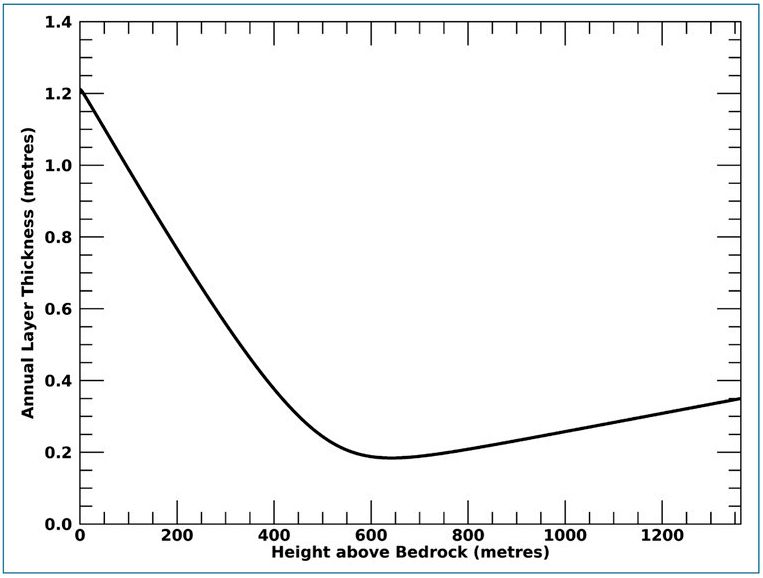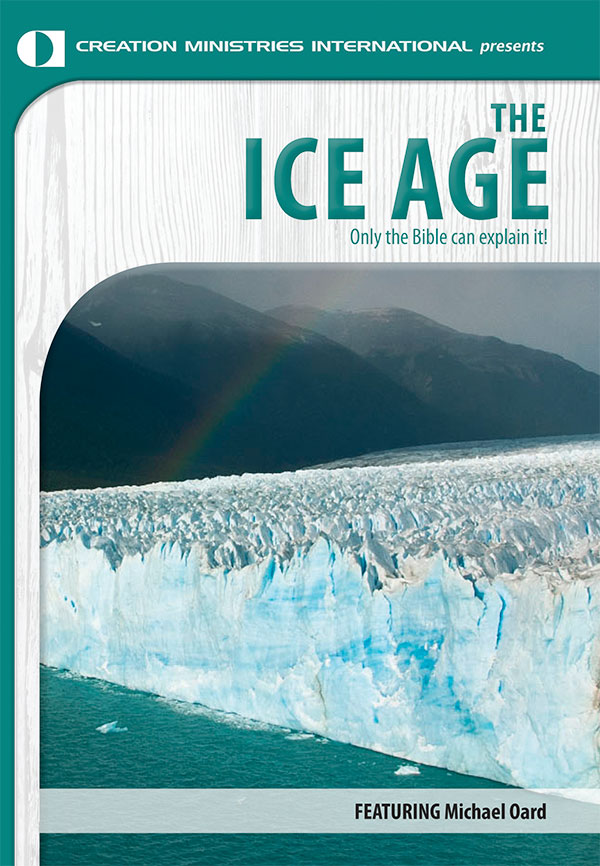Journal of Creation 35(3):12–14, December 2021
Browse our latest digital issue Subscribe
The current state of creationist ice core research

Although the ability of the Flood to explain the Ice Age is one of the great strengths of the Creation model,1,2 Bible skeptics claim the vast ages assigned to deep Greenland and Antarctic ice cores are insurmountable challenges to the Bible’s 6,000-year chronology.
However, thick ice sheets do not need millions of years to form. Uniformitarian glaciologists acknowledge thick ice sheets can form in thousands of years, given sufficiently high ice accumulation rates.3,4 Hence, the high Ice Age accumulation rates posited by the Creation Ice Age model can plausibly enable thick ice sheets to have formed in the 4,500 years since the Flood.
Moreover, dating of ice cores is not easy. If annual accumulation rates are high enough, as is the case in central Greenland, visible bands within the ice may be counted directly. However, if accumulation rates are too low, as is the case for the deep cores in East Antarctica, direct counting of layers is not possible,5,6 so glaciologists use theoretical age-date models to assign ages to different depths within the ice. These models attempt to take into account thinning of the ice, but without performing the ‘brute force’ calculations discussed below.
These models implicitly assume ‘millions of years’ by taking the height of the ice sheet to be constant or nearly constant.7-9 The rationale for this is that any error introduced into the age model by neglecting the thousands of years for the ice sheet’s formation will be negligible compared to the millions of years during which the ice sheet has supposedly been in existence. Hence, the ‘constant height’ assumption implicitly assumes ‘deep time’, and the vast ages assigned to the deep Antarctic cores are unsurprising.
The ages assigned to the deep Greenland cores are obtained by counting of visible ice layers.10 Hence, some Bible skeptics see the deep Greenland ice cores as unanswerable challenges to biblical creation.11 However, multiple layers are deposited per year, and the number of these layers can vary from year to year.12 Hence, scientists must make educated guesses about how many visible bands should be grouped together and counted as representing a single year, which is not a trivial task. In fact, some glaciology pioneers suggested that counting could yield ages of 10% accuracy or better only for ice less than 200 years old!13 Secular glaciologists now think they can count back tens of thousands of years with an accuracy of 10%.14 This earlier pessimism is more realistic, as demonstrated when uniformitarian glaciologists increased their assigned age for the bottom of the GISP2 core from 85,000 years to 111,000 years simply by increasing the resolution of their dust measurements in the bottom 500 m of the core!15
Interestingly, in the upper halves of the Greenland ice cores, creationist and uniformitarian age assignments agree to within a factor of two or three of one another.16,17 Only in the bottom halves of the Greenland cores do uniformitarian and creationist age estimates dramatically diverge. Yet, the counting process is most difficult and uncertain in the bottom core sections, where ‘jumps’ in dust content are assumed to represent seasonal cycles.18 However, several factors together can plausibly account for overcounting in the bottoms of the Greenland cores.17 First, seventyfold variations in dust content in the core bottoms complicate the counting process.19 Second, individual storms (thousands of which would be expected in a post-Flood Ice Age lasting hundreds of years) can change ice dust content.20 Third, uniformitarian expectations of very thin annual layers in the bottom core sections contribute to overcounting.17
Moreover, creationists have pointed out that the frequencies and thicknesses of tephra layers within the deep Antarctic ice cores are more consistent with young-Earth expectations21,22 as is the lack of erosion of the Gamburtsev Mountains beneath the East Antarctic ice sheet.23-25
For the above reasons, I think creationists have refuted claims that ice cores demand an old Earth. However, we have done very little actual modelling of the ice sheets. In theory, one can use a physics-based model to simulate the formation and thinning of a thick ice sheet without making the usual ‘old Earth’ assumptions. This is the ideal way to model the growth of an ice sheet: finding the stresses (forces per unit area) on parcels within the ice to directly determine how much thinning has occurred. Uniformitarians would likely never attempt to simulate the entire multi-million year assumed history of an ice sheet with a physics-based computer model, due to the enormously high computational demands. However, creationists could conceivably use such models to simulate the relatively short history of an ice sheet in the creation model.


In 1993 Larry Vardiman of the Institute for Creation Research published a one-dimensional mathematical model for the rapid formation of an ice sheet in the time since the Genesis Flood.26 This model assumed high Ice Age accumulation rates that exponentially decayed to today’s ‘slow and gradual’ rates. This model did not directly calculate the stresses on a parcel of ice but implicitly assumed that thinning of the ice at any time was proportional to the current thickness of the ice sheet.
More recently I used Vardiman’s model and a simple computer code to numerically calculate the thicknesses of annual layers within Vardiman’s model,27 as shown in figure 1. One interesting result is that in creation-based ice models the thinnest annual layers are not necessarily found at the very bottom of the ice, but can occur at intermediate depths.
However, there is a need for more sophisticated, physics-based creation ice sheet models. All such models simplify the mathematics using the fact that the height of the ice sheet is very thin compared to its horizontal dimensions (the ‘shallow ice approximation’).
One such model is the Mahaffy model, used to create figure 2.28 I have submitted a paper describing the model for publication. One of the weaknesses of the model is that it does not take into account spatial variations in the temperature of the ice. Moreover, the physics is oversimplified in that certain stresses are ignored in order to make the mathematics tractable.
A more sophisticated ‘higher order’ model is the Blatter–Pattyn model,29,30 utilized by the Community Ice Sheet Model (CISM).31 This CISM computer model is freely available to the general public, although implementation of this model may be difficult for those unfamiliar with it. I am currently working on using the Blatter–Pattyn model in some simple two-dimensional problems.
The ability of the creation model to explain the Ice Age and its associated mysteries is one of its great strengths. Nevertheless, creation researchers have some ‘catching up’ to do when it comes to computer modelling of ice sheets, and we are working to that end.
References and notes
- Oard, M.J., An Ice Age Caused by the Genesis Flood, Institute for Creation Research, El Cajon, CA, 1990. Return to text.
- Oard, M.J., The Frozen Record, Institute for Creation Research, Santee, CA, 2005. Return to text.
- Wilson, R.C.L., Drury, S.A., and Chapman, J.L., The Great Ice Age: Climate change and life (2005 electronic version), Routledge and the Open University, London and New York, p. 69, 2005. Return to text.
- Paterson, W.S.B., Ice sheets and ice shelves; in: Colbeck, S.C. (Ed.), Dynamics of Snow and Ice Masses, Academic Press, New York, p. 40, 1980. Return to text.
- Dating by forward and inverse modelling, Centre for Ice and Climate, Niels Bohr Institute, iceandclimate.nbi.ku.dk/research/strat_dating/forward_inv_modelling, accessed 17 June 2021. Return to text.
- Palerme, C., Kay, J.E., Genthon, C., L’Ecuyer, T., Wood, N.B., and Claud, C., How much snow falls on the Antarctic ice sheet? The Cryosphere Discussions 8:1279–1304, 2014. Return to text.
- Cuffey, K.M. and Paterson, W.S.B., The Physics of Glaciers, 4th edn, Butterworth-Heinemann (an imprint of Elsevier), Amsterdam, Netherlands, pp. 617–620, 2010. Return to text.
- Nye, J.F., Correction factor for accumulation measured by the thickness of the annual layers in an ice sheet, J. Glaciology 4(36):785–788, 1963. Return to text.
- Dansgaard, W. and Johnsen, S.J., A flow model and a time scale for the ice core from Camp Century, Greenland, J. Glaciology 8(53):215–223, 1969. Return to text.
- Meese, D.A., Gow, A.J., Alley, R.B., Zielinski, G., Grootes, P.M., Raouf, M.A., Taylor, K., Mayewski, P.A., and Bolzan, J.F., The Greenland Ice Sheet Project 2 depth-age scale: methods and results, J. Geophysical Research 102(C12):26411–26423, 1997. Return to text.
- Seely, P.J., The GISP2 ice core: ultimate proof that Noah’s Flood was not global, Perspectives on Science and Christian Faith 55(4):252–260, 2003. Return to text.
- Alley, R.B., Concerning the deposition and diagenesis of strata in polar firn, J. Glaciology 34(118):283–290, 1988; especially figure 2 and description on p. 283. Return to text.
- Hammer, C.U., Clausen, H.B., Dansgaard, W., Gundestrup, N., Johnsen, S.J., and Reeh, N., Dating of Greenland ice cores by flow models, isotopes, volcanic debris, and continental dust, J. Glaciology 20(82):3–26, 1978; especially table 1. Return to text.
- Meese et al., ref. 10, table 2, p. 26413. Return to text.
- Meese et al., ref. 10, pp. 26417–26418. Return to text.
- National Oceanic and Atmospheric Administration, National Climate Data Center, ncdc.noaa.gov, accessed 13 May 2014. Return to text.
- Hebert, J., Ice cores, seafloor sediments, and the age of the earth, part 2, Acts & Facts 43(7), 2014. Return to text.
- Ram, M. and Illing, M., Polar ice stratigraphy from laser-light scattering: scattering from meltwater, J. Glaciology 40(136):504–508, 1994; especially p. 507. Return to text.
- Paterson, W.S.B., Why ice-age ice is sometimes ‘soft’, Cold Regions Science and Technology 20(1):75–98, 1991. Return to text.
- Jacka, T.H., Antarctic ice cores and environmental change, Antarctic Cooperative Research Centre and Australian Antarctic Division, chem.hope.edu/~polik/warming/IceCore/IceCore2.html, accessed 17 June 2021. Return to text.
- Oard, ref. 2, p. 135. Return to text.
- Hebert, J., Tephra and inflated ice core ages, J. Creation 32(3):4–6, 2018. Return to text.
- Mustain, A., Antarctica’s Biggest Mysteries: Secrets of a Frozen World, LiveScience, livescience.com/17477-antarctica-biggest-mysteries.html, accessed 17 June 2021. Return to text.
- Oard, M.J., Little erosion beneath Antarctica and Greenland ice sheets, J. Creation 30(1):11–14, 2016. Return to text.
- Hebert, J., Youthfulness of Antarctic ice sheets, J. Creation 30(3):50–51, 2016. Return to text.
- Vardiman, L., An analytic young-Earth flow model of ice sheet formation during the ‘Ice Age’; in: Walsh, R., (Ed.), Proceedings of the Third International Conference on Creationism, Creation Science Fellowship, Pittsburgh, PA, pp. 561–568, 1994. Return to text.
- Hebert, J., Using Vardiman’s young-Earth ice sheet model and a simple computer code to estimate annual layer thicknesses, CRSQ 57(3):175–185, 2021. Return to text.
- Mahaffy, M.W., A three-dimensional numerical model of ice sheets: tests on the Barnes ice cap, Northwest Territories, J. Geophysical Research 81(6):1059–1066, 1976. Return to text.
- Blatter, H., Velocity and stress fields in grounded glaciers: a simple algorithm for including deviatoric stress gradients, J. Glaciology 41(138):333–344, 1995. Return to text.
- Pattyn, F., A new three-dimensional higher-order thermomechanical ice sheet model: basic sensitivity, ice stream development, and ice flow across subglacial lakes, J. Geophysical Research 108, no. B8, 2003 ǀ doi.org/10.1029/2002JB002329. Return to text.
- Lipscomb, W.H., Price, S.F., Hoffman, M.J., Leguy, G.R., Bennett, A.R., Bradley, S.L., Evans, K.J., Fyke, J.G., Kennedy, J.H., Perego, M., Ranken, D.M., Sacks, W.J., Salinger, A.G., Vargo, L.J., and Worley, P.H., Description and evaluation of the Community Ice Sheet Model (CISM) v2.1, Geoscientific Model Development 12:387–424, 2019. Return to text.



Readers’ comments
Comments are automatically closed 14 days after publication.